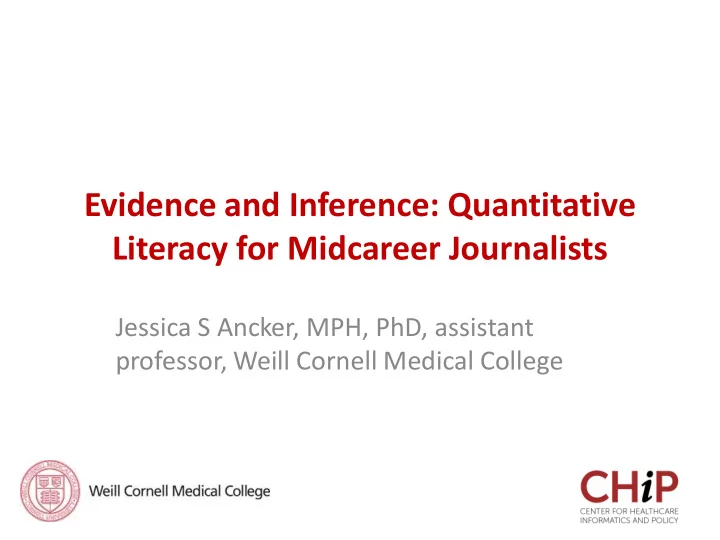

Evidence and Inference: Quantitative Literacy for Midcareer Journalists Jessica S Ancker, MPH, PhD, assistant professor, Weill Cornell Medical College
2
Evidence and Inference • Advanced research techniques • Gathering and assessing information • Statistical literacy • Cognitive/psychological biases • Rigorous interviewing techniques Nicholas • Understanding the work of experts Lemann, Dean, • Locating material in historical archives and Columbia databases Journalism • Testing assumptions and hypotheses School • Recognizing ways stories can distort the truth • Making sure that reporting firmly proves its points 3
Columbia MA program • Students: – Midcareer – PowerPoint-naive – Intense listeners/notetakers – Recognize value in topic – Uninterested in grades – Interested in defense and offense – Have never opened Excel – Math-phobes 4
Case example: Data distributions • Measure heart rates in class, captured in spreadsheet, graphs 5
Case example: Data distributions • Measure heart rates in class, captured in spreadsheet, graphs • Income $75,000 $1,000,000 $50,000 $66,000 $96,000 average: $257,400 average: $71,750 6
Case example: Data distributions • Measure heart rates in class, captured in spreadsheet, graphs • Income $75,000 $1,000,000 $50,000 $66,000 $96,000 • Malcolm Gladwell: “Million - dollar Murray” 7
Case example: Margin of error Margin of error exists but is not acknowledged Margin of error exists and is illustrated 8
Case example: Margin of error “Mr . Obama is ahead in Florida by 49 percent to 46 percent and in Wisconsin by 49 percent to 47 percent — differences within the polls’ margin of sampling error of plus or minus three percentage points .” – Cooper and Sussman, “In poll, Obama is given trust over Medicare,” The New York Times , August 23, 2012 9
Case example: Article critique 10
Case example: Article critique 11
The original graph (p. 42). The claim: Strontium levels were higher in children who lived within 40 miles of nuclear plants (gray bars) than in those who lived farther away (black bars).
200 200 180 180 160 160 140 140 120 120 100 100 80 80 60 60 40 40 20 20 0 0 1 2 3 4 5 6 If we fix the y axis, the bars will be proportionate
200 200 180 160 150 140 120 100 100 80 60 50 40 20 0 0 Sample data are merely estimates of population values. 1 2 3 4 5 6 The 95% confidence intervals (“margins of error”) show ranges for the population numbers that are compatible with the sample data, given the errors
200 200 180 160 150 140 120 100 100 80 60 50 40 20 0 0 Now we can see that in 3 of the 6 comparisons, the mean from one 1 2 3 4 5 6 bar is within the margin of error for the other one. For these comparisons, we are less sure that the means are different.
Approach and lessons • Keep it grounded in current events • Goal should be for every single person to take away something useful 1. Begin with intuitive gist and examples 2. Follow with simple math 3. Recap with gist and examples • Don’t underestimate the degree of math anxiety in this population! 16
Thank you! Jessica S Ancker, MPH, PhD Center for Healthcare Informatics and Policy Weill Cornell Medical College jsa7002@med.cornell.edu 17
Recommend
More recommend